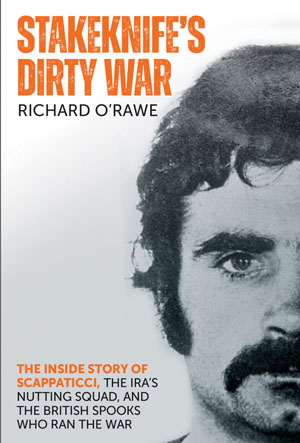RICHARD O’RAWE
Merrion Press
€18.99
ISBN 9781785374470
Reviewed by Kevin Kiely

Kevin Kiely is author of Yrland regained: central cantos (Amazon Books, 2020).
O’Rawe’s intense, graphic account is based on eyewitness testimony of other IRA volunteers and himself: ‘I knew Freddie Scappaticci […] he and I had been interned without trial in the cages of Long Kesh prison’. Scappaticci, known as ‘Scap’ and ‘Stakeknife’, was Italian in background; his father, born in Belfast, had ‘several ice cream vans on the road’. ‘Scap’ (1946–2023) became an apprentice bricklayer at the age of twenty, marrying Sheila Cunningham, and eventually six children followed. The biography shows the British deep state running ‘Scap’ as a double agent/informer on the IRA. He got involved in ‘illegal tax scams’ as a building site contractor; renovated his Farnham Street (Belfast) property; and holidayed in ‘Venice, Italy, as well as trips to France, Bulgaria and Florida’, not least European skiing holidays—a protected, superannuated untouchable by London’s Downing Street.
In the IRA’s internal security unit (ISU), whom ‘the press would dub the ‘nutting squad’, Scap ‘appeared to be the perfect IRA volunteer: he was, on the outside, a conscientious family man even though he was a porn addict who had extra-marital affairs’ and was identified as ‘paedophilic’. The interrogations and executions of informers (touts) alongside their backgrounds are paralleled in fast-forward through the Troubles up to the Good Friday Agreement, the Kenova Inquiry and the (shelved) Legacy Bill.
Exacting detail explores the FRU (Force Research Unit) 1980–95, ‘Britain’s secret war on the IRA […] responsible for running over 100 agents, including Freddie Scappaticci’. The FRU, involved with the RUC’s Special Branch and MI5, was created by Margaret Thatcher and her ally Maurice Oldfield, former chief of MI6. Deep state planned killings from Downing Street meant death for many, including Pat Finucane, ‘by loyalists acting on intelligence by the FRU agent Brian Nelson, a leading member of the Ulster Defence Association (UDA)’. O’Rawe’s vast resources prove that ‘Scappaticci was involved in eighteen murders’ for Downing Street and had ‘been informing since 1977’; cross-referencing of eyewitness testimony enables continual fact-checking on these horrific events.
Ian Hurst is a key source, duplicitously as a former member of the FRU behind numerous shoot-to-kill operations and later becoming a ‘respectable’ whistle-blower. The deliberately aborted ‘hit’ on Gerry Adams (1984) by loyalist gunmen meant that ‘members of the security forces (FRU) watched the incident on concealed cameras’. Hurst, using various aliases, such as Martin Ingram, co-authored Stakeknife: Britain’s secret agents in Ireland (2004). Posing as Channel 4 reporter ‘Jeremy Giles’, he interviewed John Wilsey (British Army in Northern Ireland). The transcript excerpts prove the widespread collusion—‘we knew we had this source, Stakeknife, and it was the golden egg’ (Wilsey). Note the use of ‘it’ rather than ‘he’, as touts were valuable but expendable.
O’Rawe gives a psycho-psychological profile of Scap, with British Intelligence ‘prepared to use every trick in the book to turn [PIRA] volunteers, to get them on their payroll’. The profiles of the informers meeting their fate acting as double agents unrolls in chapter after chapter in documentary style.
Scap’s undoing happened when interrogating fellow IRA spy-informer Sandy Lynch, who was ‘wired’. Lynch received two bullets to the back of the head, like many others had, which protected Scappaticci’s identity. After the Lynch ISU interrogation Scappaticci moved to Dundalk, trying to dispel growing suspicion of him by the IRA.
The expert sources include Thatcher, briefing Raymond White on her visit to South Armagh. White questioned her about the shoot-to-kill policy—‘the grey area that hadn’t been legislated for in the management of any agent. You were asking that individual to act as a terrorist’—to which she replied, ‘carry on what you’re doing, but don’t get caught’. Thatcher as prime minister cultivated IRA informers such as Willie Carlin from Derry, outed as a tout. ‘Carlin and his family were spirited out of Derry and Ireland on board Margaret Thatcher’s private jet. And so, for Agent 3007, it was all over.’ Thatcher on meeting him said, ‘Can I say I am extremely proud of what you achieved’.
O’Rawe admits that ‘it was accepted that informers and state agents would be executed by the IRA’. Martin McGuinness went further: ‘it is quite acceptable to take the life of anyone who is in the pay of the British Crown. I don’t see it as murder.’ Danny Morrison compounds the IRA’s anathema on spies: ‘10 Downing Street knew about Freddie Scappaticci and every other informer. He was discussed over dinner, with cigars and Chablis. Scappaticci was the prime minister’s man.’
The truth about Scappaticci became international news in May 2003. O’Rawe remarks that ‘he was not just a spy who came in from the cold but one who warmed his hands at the turf fire with the IRA’s generals’. He skulked about for another twenty years while the Kenova Inquiry supported his lies: ‘We were made aware [last week] of the passing of Freddie Scappaticci […] and continue to actively pursue criminal charges against certain individuals’. O’Rawe concludes: ‘No one knows where or when he was buried, or if he was cremated. No cause of death has been given to the media.’ The Kenova Inquiry had led to Scappaticci’s only (ever) conviction—‘three months imprisonment, suspended for a year’, on ‘a charge of possessing extreme pornographic images on his computer, mostly of bestiality’. During his time in Belfast, he used ‘a sock containing a brick’ amongst other weapons of torture. Collectively, unanimously, it is clear that ‘Scappaticci was one of the most callous blackguards ever to pollute Irish history’
